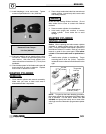
BRAKES
9.5
REAR AUXILIARY MASTER CYLINDER
Frame
Bushing
Bushing
Washer
Washer
Screw
Spring
Screw
Rear Brake
Master Cylinder
Rear Brake Line
Seal
Bolt
Brake Reservoir
Clamp
Reservoir Hose
Brake Mount
BRAKE SYSTEM SERVICE
NOTES
Polaris disc brake systems are light weight, low
maintenance and perform well in the conditions ATVs
routinely encounter. However, there are a few things
to remember when replacing disc brake pads or
performing brake system service to ensure proper
system function and maximum pad service life.
S Perform a brake burnishing
procedure after installing new pads
to maximize service life.
S Optional pads are available to suit
conditions in your area. Select a pad
to fit riding style and environment.
S Do not over-fill the master cylinder
fluid reservoir.
S Make sure the brake lever and pedal
returns freely and completely.
S Adjust stop pin on front caliper after
pad service.
S Check and adjust master cylinder
reservoir fluid level after pad service.
S Make sure atmospheric vent on
reservoir is unobstructed.
S Test for brake drag after any brake
system service and investigate
cause if brake drag is evident.
S Make sure caliper moves freely on
guide pins (where applicable).
S Inspect caliper piston seals for
foreign material that could prevent
caliper pistons from returning freely.
CAUTION:
Use only DOT 3 brake fluid as an
assembly aid for all procedures described in this chapter to
prevent brake system contamination. DO NOT USE
LUBRICANTS OF ANY KIND FOR ASSEMBLY, AS THEIR
USE CAN CAUSE RUBBER COMPONENTS TO SWELL.
BRAKE NOISE
TROUBLESHOOTING
Dirt or dust buildup on the brake pads and disc is the
most common cause of brake noise (squeal caused
by vibration). If cleaning does not reduce the
occurrence of brake noise, Permatext Disc Brake
Quiet (PN 2872113) can be applied to the back of the
pads. Follow directions on the package. This will
keep pads in contact with caliper piston(s) to reduce
the chance of squeaks caused by dirt or dust.


















